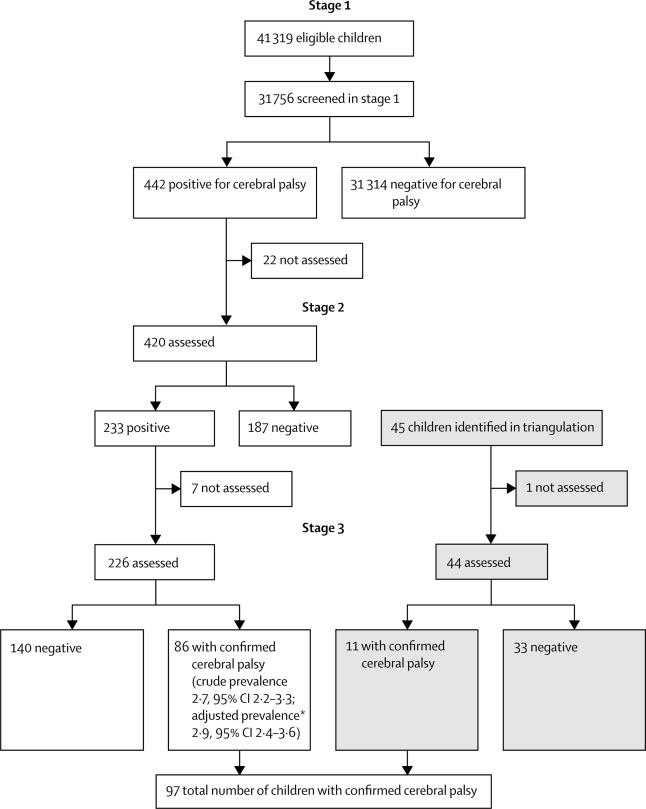The Lancet Global Health ( IF 19.9 ) Pub Date : 2017-11-05 , DOI: 10.1016/s2214-109x(17)30374-1 Angelina Kakooza-Mwesige , Carin Andrews , Stefan Peterson , Fred Wabwire Mangen , Ann Christin Eliasson , Hans Forssberg

|
Background
Few population-based studies of cerebral palsy have been done in low-income and middle-income countries. We aimed to examine cerebral palsy prevalence and subtypes, functional impairments, and presumed time of injury in children in Uganda.
Methods
In this population-based study, we used a nested, three-stage, cross-sectional method (Iganga-Mayuge Health and Demographic Surveillance System [HDSS]) to screen for cerebral palsy in children aged 2–17 years in a rural eastern Uganda district. A specialist team confirmed the diagnosis and determined the subtype, motor function (according to the Gross Motor Function Classification System [GMFCS]), and possible time of brain injury for each child. Triangulation and interviews with key village informants were used to identify additional cases of suspected cerebral palsy. We estimated crude and adjusted cerebral palsy prevalence. We did χ2 analyses to examine differences between the group screened at stage 1 and the entire population and regression analyses to investigate associations between the number of cases and age, GMFCS level, subtype, and time of injury.
Findings
We used data from the March 1, 2015, to June 30, 2015, surveillance round of the Iganga-Mayuge HDSS. 31 756 children were screened for cerebral palsy, which was confirmed in 86 (19%) of 442 children who screened positive in the first screening stage. The crude cerebral palsy prevalence was 2·7 (95% CI 2·2–3·3) per 1000 children, and prevalence increased to 2·9 (2·4–3·6) per 1000 children after adjustment for attrition. The prevalence was lower in older (8–17 years) than in younger (<8 years) children. Triangulation added 11 children to the cohort. Spastic unilateral cerebral palsy was the most common subtype (45 [46%] of 97 children) followed by bilateral cerebral palsy (39 [40%] of 97 children). 14 (27%) of 51 children aged 2–7 years had severe cerebral palsy (GMFCS levels 4–5) compared with only five (12%) of 42 children aged 8–17 years. Few children (two [2%] of 97) diagnosed with cerebral palsy were born preterm. Post-neonatal events were the probable cause of cerebral palsy in 24 (25%) of 97 children.
Interpretation
Cerebral palsy prevalence was higher in rural Uganda than in high-income countries (HICs), where prevalence is about 1·8–2·3 cases per 1000 children. Children younger than 8 years were more likely to have severe cerebral palsy than older children. Fewer older children than younger children with cerebral palsy suggested a high mortality in severely affected children. The small number of preterm-born children probably resulted from low preterm survival. About five times more children with post-neonatal cerebral palsy in Uganda than in HICs suggested that cerebral malaria and seizures were prevalent risk factors in this population.
Funding
Swedish Research Council, Promobilia.
中文翻译:

乌干达脑性瘫痪患病率:一项基于人群的研究
背景
在低收入和中等收入国家,很少进行基于人群的脑瘫研究。我们旨在检查乌干达儿童的脑瘫患病率和亚型,功能障碍以及预计的受伤时间。
方法
在这项基于人群的研究中,我们使用嵌套的三阶段横断面方法(Iganga-Mayuge健康和人口统计学监视系统[HDSS])来筛查乌干达东部农村地区2-17岁儿童的脑瘫区。一个专家小组对诊断进行了确认,并确定了每个儿童的亚型,运动功能(根据大运动功能分类系统[GMFCS])以及可能的脑损伤时间。三角剖分和对主要村庄线人的采访被用来确定其他疑似脑瘫病例。我们估计了粗略的和调整后的脑瘫患病率。我们做了χ 2 分析以检查在第1阶段筛查的人群与整个人群之间的差异,并进行回归分析以调查病例数与年龄,GMFCS水平,亚型和受伤时间之间的关联。
发现
我们使用了2015年3月1日至2015年6月30日Iganga-Mayuge HDSS监视回合的数据。对31 756名儿童进行了脑瘫筛查,在第一筛查阶段筛查呈阳性的442名儿童中,有86名(19%)证实了这一点。每1000名儿童的粗略脑瘫患病率为2·7(95%CI 2·2-3·3),经过减员调整后,患病率增加到每1000名儿童2·9(2·4-3·6)。年龄较大的儿童(8-17岁)的患病率低于年龄较小的儿童(<8岁)。三角剖分使该队列增加了11个孩子。痉挛性单侧脑瘫是最常见的亚型(97名儿童中的45名[46%]),其次是双侧脑瘫(97名儿童中的39名[40%])。51位2-7岁儿童中有14位(27%)患有严重的脑瘫(GMFCS水平为4-5),而42位8-17岁儿童中只有5位(12%)。几例被诊断出患有脑瘫的儿童(占97%的两个[2%])出生于早产儿。新生儿后事件是97名儿童中24名(25%)患脑瘫的可能原因。
解释
乌干达农村地区的脑瘫患病率高于高收入国家(HIC),后者的患病率约为每1000名儿童1·8-2·3例。与年龄较大的儿童相比,年龄小于8岁的儿童更可能患有严重的脑瘫。患重度麻痹的儿童中,年龄较大的儿童比年龄较小的儿童少,这表明死亡率较高。早产儿很少,可能是由于早产存活率低。乌干达患新生儿后脑瘫的儿童大约是高收入国家儿童的五倍,这表明脑疟疾和癫痫发作是该人群中普遍的危险因素。
资金
瑞典研究委员会,Promobilia。











































 京公网安备 11010802027423号
京公网安备 11010802027423号